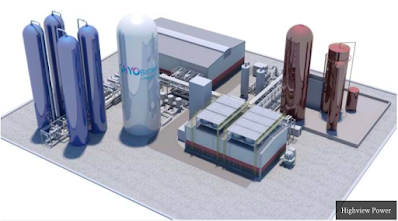 |
| Highview Power cryogenic energy storage system |
As the UK moves to net zero emissions by 2050 it is going to need much more battery storage to stabilise the grid as the number of solar and wind energy plants increase. So much so, the government is to relax the planning laws to make it easier to develop larger battery storage systems. The legislation will be introduced to remove barriers for storage projects above 50MW (megawatts) in England and 350MW in Wales.
This will allow the UK company Highview Power (and others) to plan to build much larger electricity storage systems. Highview Power makes cryogenic storage plants that use [renewable] electricity to cool air to a liquid and store it in insulated tanks. The liquid air is then warmed by stored heat from the process to expand the gas 700 times to drive turbines which can add electricity back to the grid when required.
The advantage of this system over chemical batteries is that it can be stored for days and can supply power for an extended period of time whereas chemical batteries can only supply power for a short period of time. Also, most of the materials and infrastructure needed are easy to obtain so the manufacture of this cryogenic battery is simple and possibly more sustainable (i.e. does not need rare metals).
Video of Highview Power Cryogenic Energy Storage System
Read more:
- UK hopes to ramp up battery storage and boost renewables by loosening planning rules. CNBC, July 15 2020.
– Highview Power to build Europe’s largest battery storage system. The Chemical Engineer, November 29, 2019.
– Highview Power to build UK’s first “liquid air” energy storage facility. RenewEconomy, October 24, 2019.
– Highview Power: https://highviewpower.com/.



